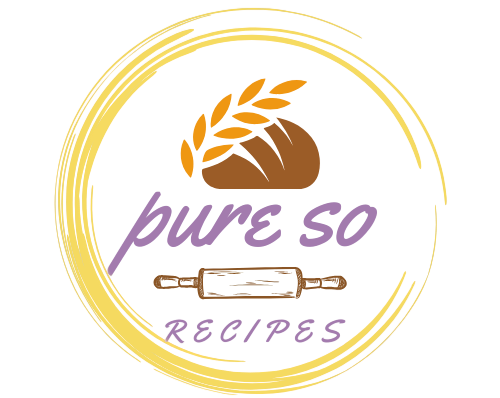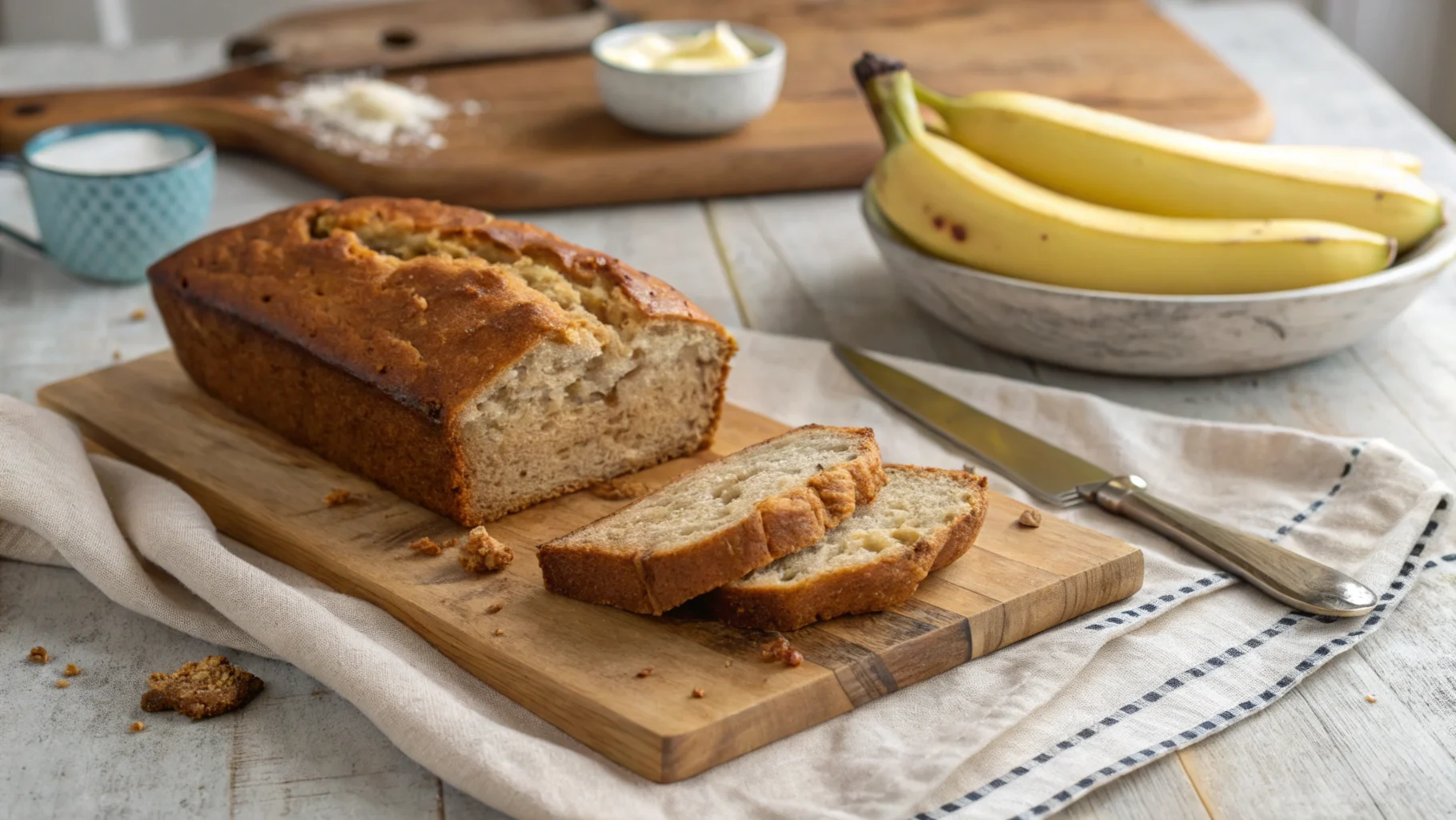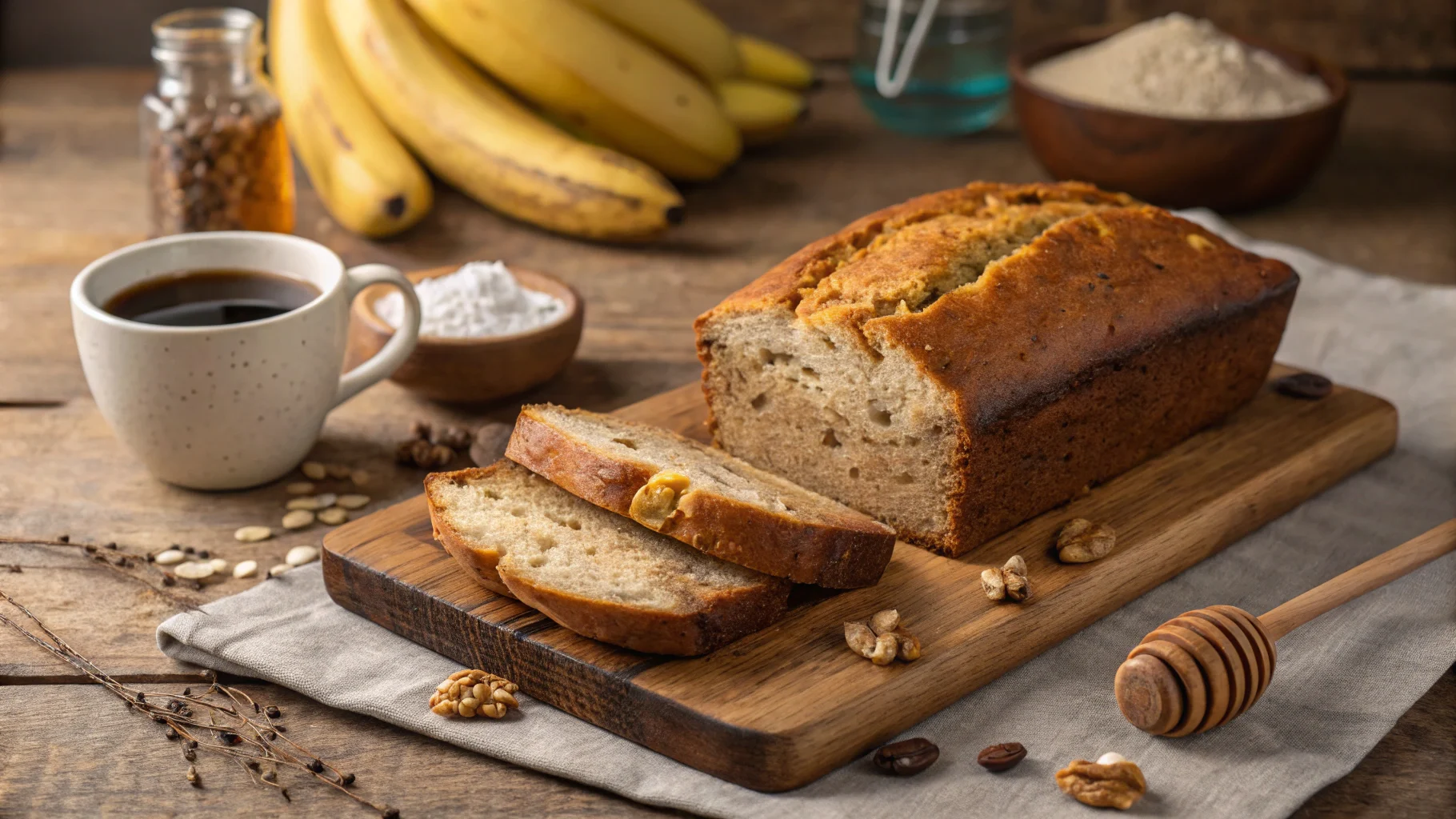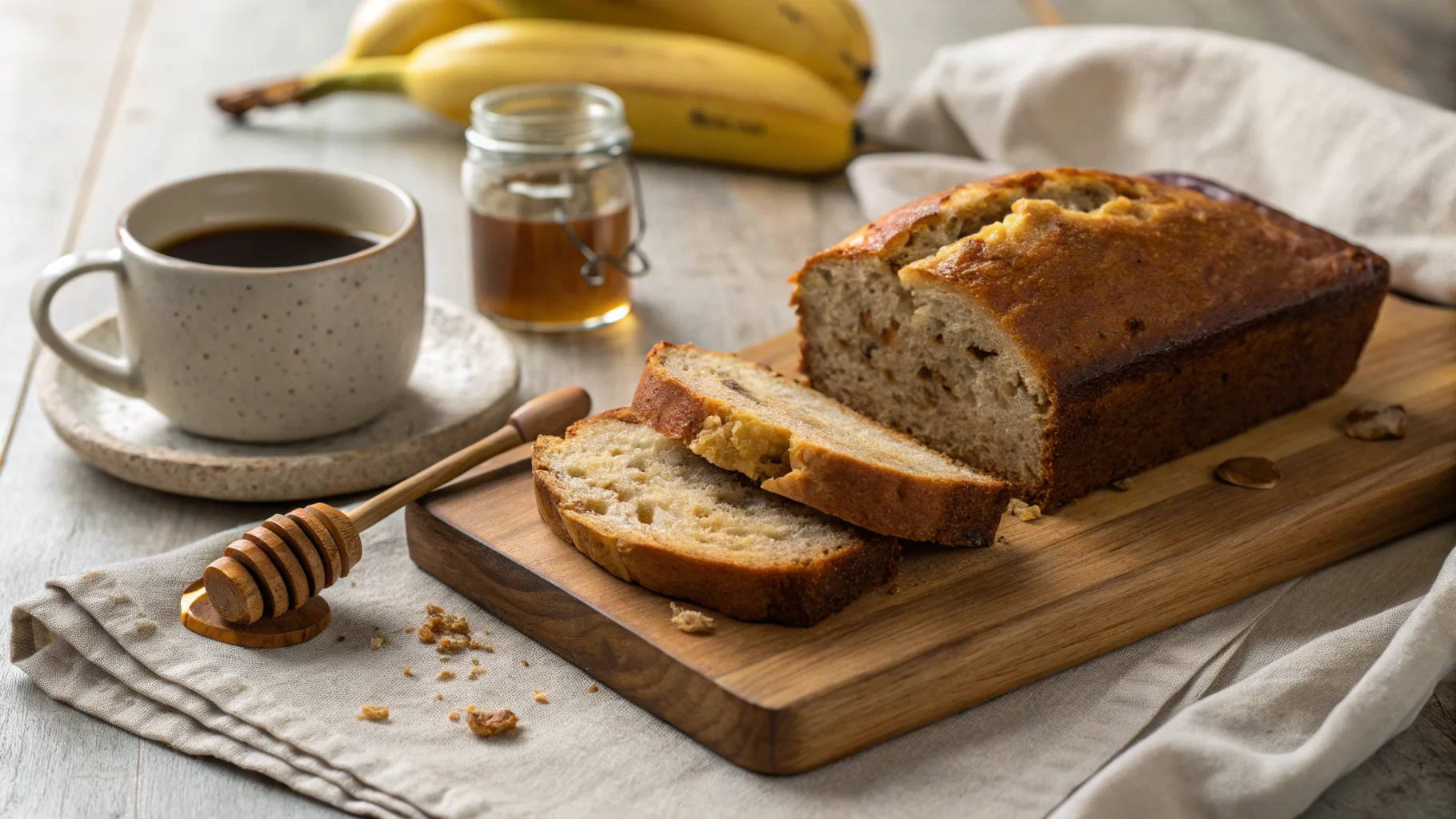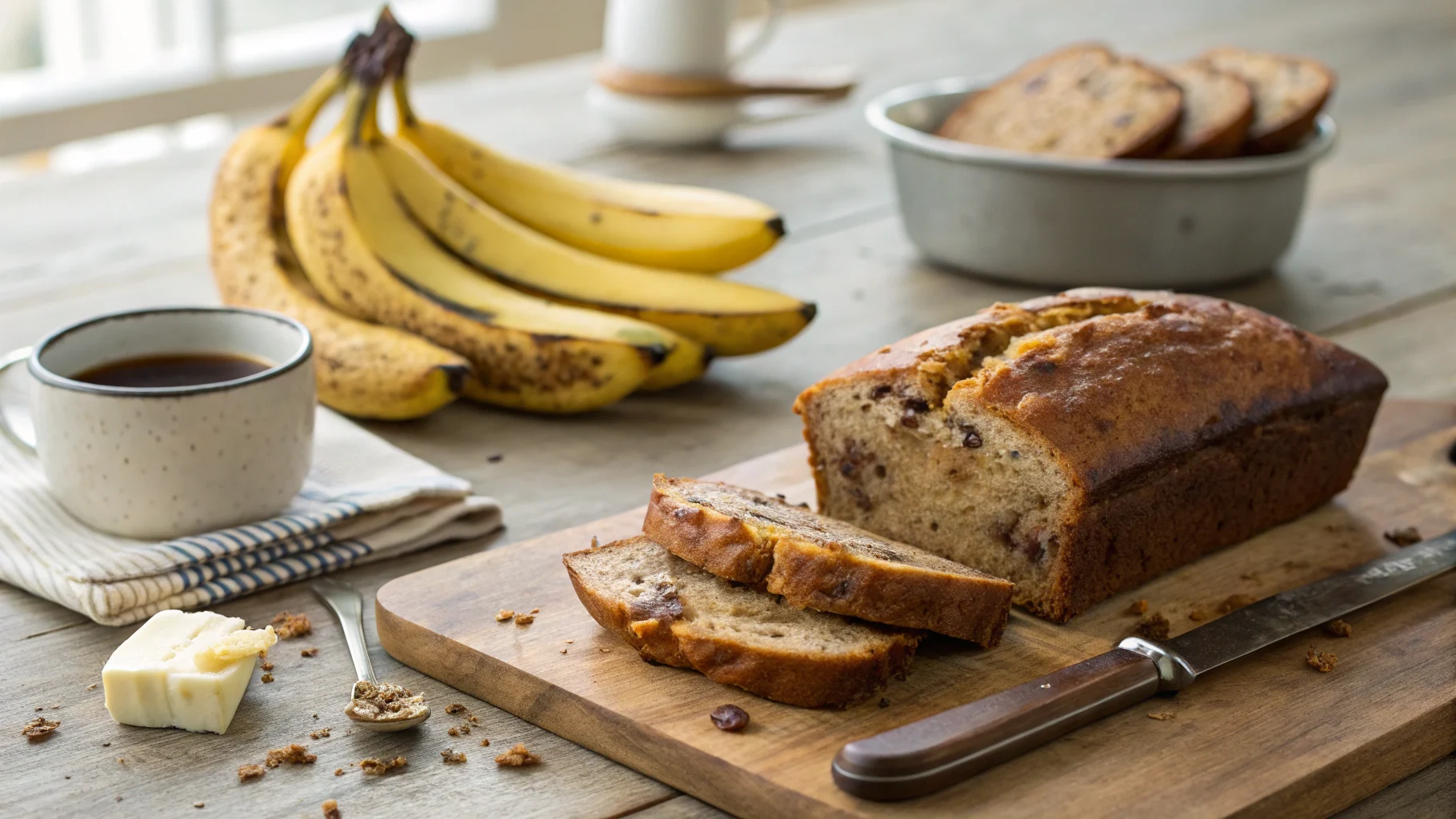Banana bread is a favorite for many, but what happens when you run out of vegetable oil or want a healthier alternative? What is a substitute for vegetable oil in banana bread? The good news is that several ingredients can replace oil without sacrificing taste or texture. Whether you want a dairy-free option, a lower-fat choice, or something to enhance flavor, there’s an alternative for every need.
Table of contents
What is a Substitute for Vegetable Oil in Banana Bread and Why Use One?
The Role of Vegetable Oil in Banana Bread
Vegetable oil plays a crucial role in banana bread, affecting moisture, texture, and overall quality. Without it, the bread may turn out dry or crumbly. Oil works by coating flour proteins, preventing excess gluten development and resulting in a softer crumb.
Additionally, oil acts as a fat source, distributing moisture evenly throughout the batter. This ensures the bread remains tender and doesn’t become too dense. While butter can also add richness, oil is often preferred for its neutral taste and ability to retain moisture for longer periods.
Since banana bread is naturally dense due to the mashed bananas, oil prevents it from becoming heavy. Choosing the right vegetable oil substitute ensures a delicious outcome with a soft, moist texture.
Reasons for Seeking Alternatives
There are several reasons why people look for substitutes for vegetable oil in banana bread:
- Running out of oil: Sometimes, you start baking only to realize you’re out of oil. Instead of running to the store, common pantry staples can work as quick alternatives.
- Health-conscious choices: Many bakers want to reduce calories and fat without sacrificing flavor. Some substitutes offer lower fat content while maintaining moisture.
- Dietary restrictions: Those avoiding dairy, soy, or processed oils may need alternatives that align with their dietary needs.
- Enhancing nutritional value: Some options, such as mashed fruit or yogurt, provide extra vitamins, minerals, and fiber.
Since vegetable oil is a refined fat, some prefer natural ingredients that offer added health benefits. Finding a good alternative ensures you still achieve a tender, flavorful banana bread.
How Substitutes Affect the Flavor of Banana Bread
The choice of vegetable oil substitute can affect the final taste of banana bread. While oil has a neutral flavor, some alternatives introduce subtle changes:
- Applesauce: Adds a mild fruitiness and a slightly denser texture.
- Mashed bananas: Enhances the natural banana flavor and makes the bread slightly sweeter.
- Butter: Gives a richer, more indulgent taste but creates a denser loaf.
- Avocado: Adds a creamy texture with a hint of earthiness.
- Greek yogurt: Introduces a slight tang and extra protein, making the bread moist and fluffy.
Choosing the right substitute depends on whether you prefer a neutral taste or an enhanced flavor profile. Some substitutes may also require slight adjustments to sugar or liquid ratios.
Common Characteristics of the Best Substitutes for Vegetable Oil in Banana Bread
When replacing vegetable oil in banana bread, it’s important to consider key characteristics that ensure a successful swap:
- Moisture Retention: Keeping the bread soft is essential. Ingredients like yogurt, applesauce, and mashed bananas maintain the necessary hydration.
- Neutral or Complementary Flavors: The best substitutes should either match the existing taste or enhance it naturally.
- Health Benefits: Many alternatives, such as fruit purees, offer additional fiber, vitamins, and minerals while reducing overall fat content.
Since banana bread relies on fat to achieve the right consistency, it’s important to choose a substitute that mimics the texture and moisture provided by vegetable oil. Whether you’re making a healthier version or simply working with what’s available, these substitutes ensure your banana bread turns out just as delicious.
Best Substitutes for Vegetable Oil in Banana Bread
When baking banana bread, vegetable oil plays an important role in keeping the loaf moist and soft. However, there are plenty of alternatives that can work just as well, if not better. What is a substitute for vegetable oil in banana bread? The answer depends on what you have available and the flavor or texture you want to achieve.
Whether you are looking for a healthier option, a dairy-free substitute, or a richer taste, there are many ingredients that can replace vegetable oil without compromising the quality of your banana bread. Below are some of the best substitutes and how to use them effectively.
Applesauce as a Substitute for Vegetable Oil in Banana Bread
How Applesauce Enhances Texture and Sweetness
Applesauce is one of the most popular substitutes for vegetable oil in banana bread because it provides natural moisture and a mild sweetness. Since applesauce contains a high water content, it keeps the bread soft without making it greasy. It also helps bind the ingredients together, ensuring a well-structured loaf.
Another benefit of applesauce is that it adds a slight fruitiness, which can complement the banana flavor without overpowering it. The texture remains light and fluffy, making it an excellent alternative for those who prefer a moist and tender bread.
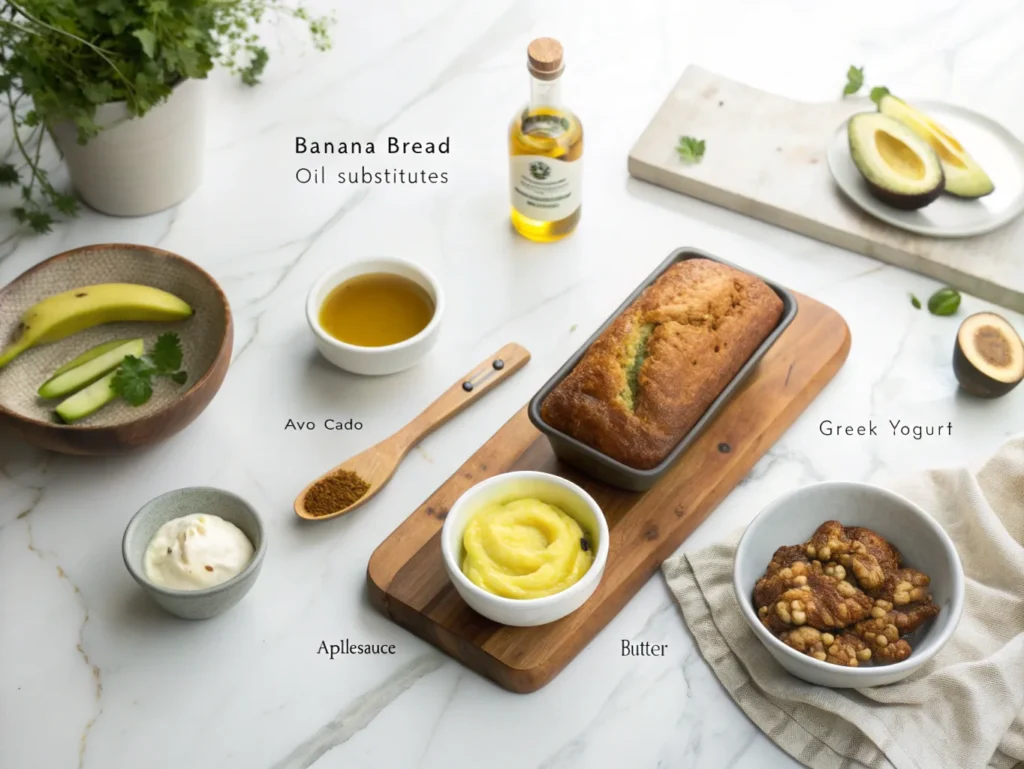
Benefits of Unsweetened Applesauce
- Reduces overall sugar content, making it ideal for health-conscious bakers.
- Lowers fat and calorie intake without sacrificing texture.
- Contains fiber and vitamins, adding extra nutritional value.
- Provides a dairy-free and vegan-friendly alternative.
Using unsweetened applesauce is the best option because it ensures you have full control over the sweetness of your banana bread. Sweetened varieties may require adjustments to the sugar in the recipe.
Ratio for Substitution
When replacing vegetable oil with applesauce, use a 1:1 ratio. If the recipe calls for 1/2 cup of oil, substitute it with 1/2 cup of applesauce. However, if you want a lighter texture, try using 3/4 applesauce and 1/4 oil to balance moisture and structure.
Mashed Bananas for Extra Flavor in Banana Bread
Enhancing Flavor with Extra Mashed Bananas
Since banana bread already contains bananas, increasing the amount of mashed bananas is a natural way to replace vegetable oil. This method not only maintains moisture but also intensifies the banana flavor. Using ripe bananas works best because they are softer and provide more natural sweetness.
Bananas contain natural sugars and fiber, which improve the texture and taste of banana bread. Additionally, they help keep the bread moist without making it overly dense.
Adjusting Liquid Content for the Right Consistency
When using mashed bananas as a substitute, it is important to adjust the other liquids in the recipe to maintain the right consistency. Too much banana can make the batter overly thick, so reducing the amount of milk or eggs slightly may help.
Substitution ratio: Replace vegetable oil with an equal amount of mashed banana (1:1 ratio). However, if using extra bananas makes the batter too thick, adding a few tablespoons of milk or water can balance the consistency.
Using Unsalted Butter Instead of Vegetable Oil in Banana Bread
Using Melted Butter for Moisture and Creaminess
If you want a richer taste, unsalted butter is a great alternative to vegetable oil in banana bread. Butter enhances the overall flavor, creating a creamy and indulgent texture. Unlike oil, which is completely liquid, butter adds a slight firmness to the crumb while keeping the bread soft.
1:1 Substitution Ratio
The standard substitution for vegetable oil is 1:1. If the recipe calls for 1/2 cup of oil, use 1/2 cup of melted butter instead. Melted butter blends smoothly with the other ingredients, ensuring even moisture distribution.
Potential for a Denser Bread
Since butter solidifies when cooled, banana bread made with butter tends to be slightly denser than versions made with oil. To counteract this, adding an extra tablespoon of milk or yogurt can help maintain a lighter texture.
Avocado – A Healthy Substitute for Vegetable Oil in Banana Bread
Health Benefits of Using Avocado
Avocado is a nutrient-dense substitute that offers healthy fats, fiber, and vitamins. It provides the moisture needed for banana bread while also delivering a creamy texture. Unlike oil, avocado adds heart-healthy monounsaturated fats, which support overall wellness.
How Avocado Affects Texture and Flavor
- Creates a smooth, velvety crumb without making the bread greasy.
- Does not overpower the banana flavor when used in moderation.
- Helps bind the ingredients together, ensuring a well-structured loaf.
Mashing and Using a 1:1 Ratio
To substitute vegetable oil, mash ripe avocado into a smooth paste and use a 1:1 ratio. Since avocado is thicker than oil, blending it well ensures a uniform texture. If the batter feels too thick, adding a tablespoon of water or milk can help maintain balance.
Yogurt as a Dairy-Based Substitute for Vegetable Oil in Banana Bread
Adding Tanginess and Creaminess with Yogurt
Using yogurt instead of vegetable oil adds a slight tang and extra creaminess to banana bread. This option is excellent for those who want a richer flavor with added protein and calcium.
Protein and Calcium Benefits
- Supports a healthy texture while adding nutritional value.
- Helps create a moist and tender crumb without making the bread heavy.
- Provides probiotics that aid digestion when using cultured yogurt.
Choosing the Right Type of Yogurt
For the best results, use plain or Greek yogurt. Greek yogurt is thicker and tangier, while regular yogurt is slightly milder. If using Greek yogurt, thinning it with a tablespoon of milk may help balance the consistency.
Substitution ratio: Replace vegetable oil with an equal amount of yogurt (1:1 ratio).
Other Fruit Purees That Can Replace Vegetable Oil in Banana Bread
Using Pureed Fruits for Moisture and Sweetness
If you want to experiment with different flavors, other fruit purees can replace vegetable oil in banana bread:
- Strawberry puree: Adds a subtle berry sweetness.
- Prune puree: Provides natural sweetness and fiber.
- Pumpkin puree: Works well in fall recipes for a seasonal twist.
These purees maintain moisture while adding unique flavors. Using a 1:1 ratio is recommended for best results.
Olive Oil
Choosing the Right Type of Olive Oil
Olive oil can be used in banana bread, but choosing extra light or light olive oil is best. These versions have a milder taste compared to extra virgin olive oil, which has a strong, peppery flavor that may not blend well with banana bread.
Substitution ratio: 1:1 for light olive oil.
Coconut Oil
Flavor Impact of Coconut Oil
Coconut oil adds a mild coconut flavor that pairs well with banana bread. It provides the same moisture retention as vegetable oil while offering additional health benefits.
Health Benefits of Coconut Oil
- Contains medium-chain triglycerides (MCTs), which support energy metabolism.
- Helps maintain a moist texture without making the bread heavy.
- Works well for dairy-free and vegan banana bread recipes.
Each of these substitutes offers a unique twist on banana bread, ensuring you achieve the desired texture and flavor. Depending on your preference, you can choose a healthier alternative or an option that enhances richness. What is a substitute for vegetable oil in banana bread? The best choice depends on what you want to achieve, whether it’s a moist texture, a healthier option, or a richer taste.
Tips for Baking with Oil Substitutes
Switching from vegetable oil to an alternative can change the texture, flavor, and moisture of banana bread. What is a substitute for vegetable oil in banana bread? The answer depends on what you’re looking for—whether it’s a healthier option, a richer taste, or an ingredient you already have on hand.
Using the right baking techniques ensures your banana bread turns out just as soft and delicious as the original. Here are key tips for achieving the best results when baking with vegetable oil substitutes.
Adjusting Liquid Ratios
When replacing vegetable oil, it’s important to balance the moisture content. Some substitutes, such as applesauce and mashed bananas, contain more water than oil, which can affect the consistency of the batter.
- If using applesauce or yogurt, reduce other liquids in the recipe slightly to prevent excess moisture.
- When replacing oil with mashed bananas, ensure the batter isn’t too thick by adding a tablespoon of milk or water if needed.
- If using butter, it may make the batter denser, so consider adding an extra egg or a small amount of milk to lighten the texture.
Balancing the wet-to-dry ingredient ratio helps maintain the right consistency, ensuring the banana bread stays soft and doesn’t become too heavy.
Flavor Pairings
Choosing the right vegetable oil substitute can enhance the flavor of banana bread. While oil has a neutral taste, other ingredients can add unique notes that complement the banana.
- Applesauce pairs well with warm spices like cinnamon, nutmeg, or ginger.
- Mashed bananas intensify the banana flavor, making them perfect for classic banana bread.
- Yogurt adds a slight tang, which works well with honey or maple syrup.
- Coconut oil brings a subtle tropical flavor that complements chocolate chips or shredded coconut.
- Butter enhances the richness and pairs well with brown sugar and pecans.
Experimenting with flavors allows you to create a banana bread that suits your taste preferences while maintaining a moist texture.
Texture Considerations
Different substitutes impact the texture of banana bread in various ways. While some create a light and fluffy crumb, others may result in a denser loaf.
- Oil-based substitutes (olive oil, coconut oil) produce a moist and tender texture, similar to traditional banana bread.
- Butter-based versions create a denser, richer crumb with a slightly firmer structure.
- Fruit-based substitutes (applesauce, mashed bananas) add moisture but can make the bread slightly heavier.
- Yogurt or sour cream results in a fluffy and creamy texture due to the added protein.
Since banana bread is naturally dense, choosing a substitute that preserves moisture without making it overly heavy ensures a soft and enjoyable texture.
Experimenting with Combinations
Sometimes, the best results come from blending multiple substitutes rather than using just one. Mixing ingredients can balance moisture, texture, and flavor.
- Try using half applesauce and half coconut oil for a light yet moist texture.
- Combine mashed bananas and Greek yogurt for a protein-rich, naturally sweetened bread.
- Use half butter and half oil substitute to maintain moisture while keeping the richness of butter.
By experimenting with different combinations, you can find the perfect formula for your ideal banana bread.
Monitoring Baking Time
Using a vegetable oil substitute may slightly alter baking time. Since some substitutes contain more moisture, banana bread may take longer to bake.
- Check the bread 5–10 minutes before the recommended baking time to ensure it doesn’t overcook.
- If using fruit purees, expect the bread to be slightly denser, requiring a few extra minutes in the oven.
- With butter or yogurt, the crust may brown faster, so covering the bread with foil halfway through baking can prevent excessive browning.
Always use the toothpick test by inserting a toothpick in the center. If it comes out clean or with a few crumbs, the bread is ready.
Storage Advice
Proper storage ensures banana bread remains fresh and moist for days. The type of vegetable oil substitute used can affect how long it stays soft.
- Banana bread made with oil-based substitutes (olive oil, coconut oil) stays moist longer and can be stored at room temperature for up to 4 days.
- Breads with fruit purees or yogurt should be refrigerated to prevent spoilage. Wrap the loaf tightly in plastic wrap or store it in an airtight container.
- If freezing banana bread, slice it before freezing for easier serving. Wrap slices in plastic wrap and store them in a freezer bag for up to 3 months.
Reheating banana bread in the microwave for a few seconds restores its softness and makes it taste freshly baked.
Troubleshooting Common Issues
Baking banana bread with a vegetable oil substitute may lead to some unexpected issues. Here’s how to fix them:
- Bread is too dense: Add an extra egg or a tablespoon of milk to lighten the texture.
- Bread is too dry: Use a bit more substitute or add a small amount of oil or melted butter.
- Bread is too wet: Reduce the amount of liquid or increase baking time slightly.
- Crumbly texture: Try using yogurt or mashed bananas for better binding properties.
Making small adjustments helps perfect the texture and consistency of banana bread, ensuring the best results.
No Butter Banana Bread Recipe
For those who prefer to avoid butter, this simple banana bread recipe replaces butter with vegetable oil substitutes while maintaining a moist texture.
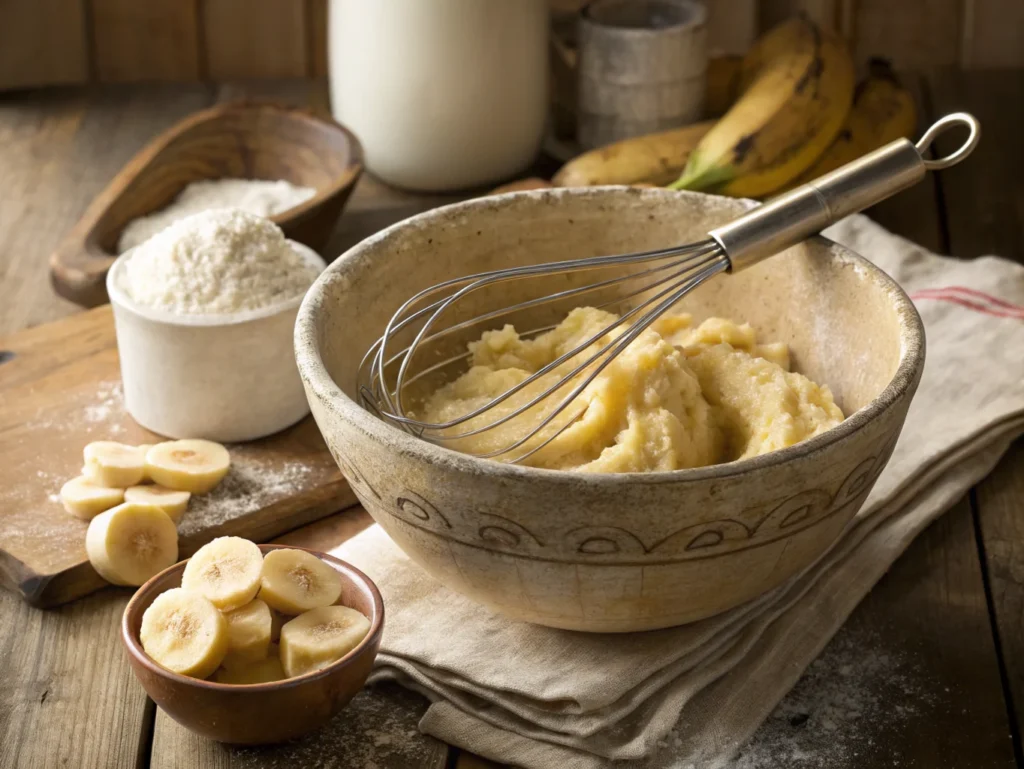
Ingredients
- 2 cups all-purpose flour
- 1 cup mashed bananas
- 1/2 cup unsweetened applesauce (or coconut oil)
- 2 large eggs
- 3/4 cup sugar
- 1 teaspoon baking soda
- 1/2 teaspoon salt
- 1 teaspoon vanilla extract
Instructions
- Preheat the oven to 350°F and grease a loaf pan.
- In a bowl, mix mashed bananas, applesauce, eggs, sugar, and vanilla.
- In another bowl, whisk together flour, baking soda, and salt.
- Combine wet and dry ingredients, stirring until just mixed.
- Pour batter into the pan and bake for 50–55 minutes or until a toothpick comes out clean.
- Let it cool before slicing.
This recipe creates a soft and flavorful banana bread without the need for butter.
Conclusion: Elevating Your Banana Bread Game
Recap of Substitutes
What is a substitute for vegetable oil in banana bread? There are many options, each offering unique benefits:
- Applesauce for a low-fat, fruity alternative.
- Mashed bananas to intensify banana flavor.
- Butter for a rich and creamy texture.
- Avocado for a healthy, creamy substitute.
- Yogurt for added protein and fluffiness.
Encouragement for Experimentation
Baking is a creative process, and trying different substitutes allows for unique results. Adjusting ratios, mixing substitutes, and adding flavors like nuts, spices, or chocolate chips can enhance your banana bread experience.
Final Tips
- Choose a substitute that aligns with your dietary needs and flavor preference.
- Experiment with different combinations for the perfect texture.
- Always check the baking time and storage method to maintain freshness.
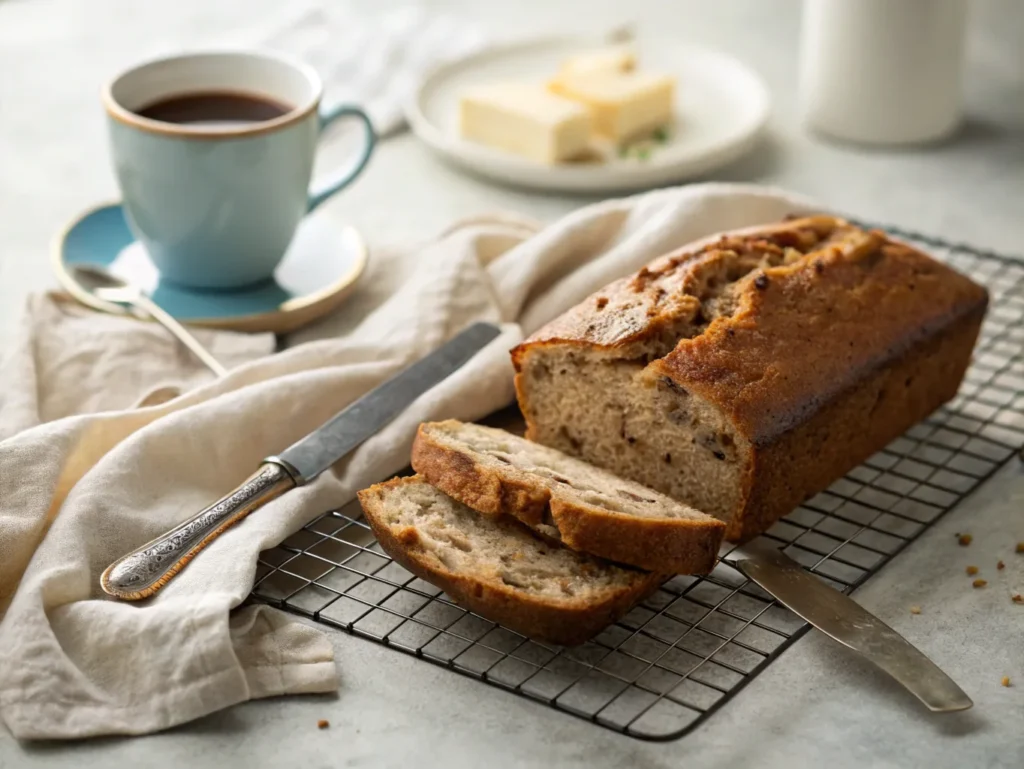
FAQs
What is a substitute for 1 cup of vegetable oil in baking?
Applesauce, mashed banana, yogurt, or melted butter can be used as substitutes. The ratio depends on the desired texture.
What is a substitute for vegetable oil in banana muffins?
Similar to banana bread, applesauce, mashed banana, yogurt, or melted butter work well in banana muffins.
Is butter or oil better for banana bread?
Oil results in a moister bread, while butter adds richness and a slightly denser texture.
Can bananas replace vegetable oil?
Yes, mashed bananas add extra flavor and moisture. Adjust liquid ratios to avoid overly wet batter.
